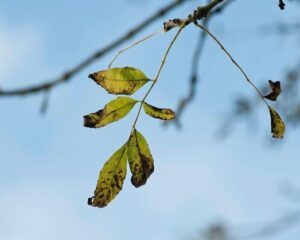Understanding Ash Dieback
Have Ash Dieback - This One's for You
What Is Ash Dieback?
Ash Dieback (Hymenoscyphus fraxineus) is a devastating fungal disease threatening the UK’s native ash trees. First confirmed in the UK in 2012 (though likely present earlier), it’s now widespread, with 80% of the UK’s ash trees expected to be lost. Originating in Asia, this disease spreads via windborne spores and infected plant material, causing irreversible decline and eventual tree death.
Unfortunately, this is a serious disease that causes our native Ash Trees to decline and eventually die, leaving them in a hazardous condition for both danger to life and buildings. Dead and Dangerous Tree removal is the only option for many Ash trees.

Spot the Signs: Symptoms of Infection
Early detection is critical. Look for these warning signs in your ash trees:
✔ Leaves: Dark summer patches, wilting, black discolouration, or premature shedding.
✔ Branches/Trunk: Dieback of shoots, diamond-shaped dark brown lesions at branch junctions, and brownish-grey inner bark under wounds.
✔ Epicormic Growth: New shoots sprouting from the trunk (a stress response).
If you notice these symptoms, act fast—infected trees become brittle and hazardous.
Why You Need a Professional
Our Glasgow-based tree surgeons can:
🔍 Confirm infection levels through expert assessment.
🌳 Recommend tailored solutions (e.g., pruning, monitoring, or safe removal).
⚠️ Prioritise safety: Diseased ash trees drop limbs unpredictably, risking property and lives.
A professional tree surgeon will be able to offer advice on removing Dangerous Trees on Private Land or commercial sites if needed to avoid potential dangers later on.
How to Slow the Spread
While the disease can’t be cured, you can help protect nearby trees:
▪ Clean shoes, bikes, and tyres after visiting wooded areas.
▪ Avoid moving ash wood or cuttings.
▪ Report suspicious symptoms to professionals immediately.
Key Facts at a Glance
Common Name – Ash dieback, chalara
Scientific Name – Hymenoscyphus fraxineus
Affected Trees – All UK ash species
Current Spread – UK-wide (incl. Glasgow)
Don’t Wait Until It’s Too Late!
If your ash trees show signs of decline, search “Tree Surgeon Near Me” or contact our certified arborists today for a risk assessment and actionable plan.
